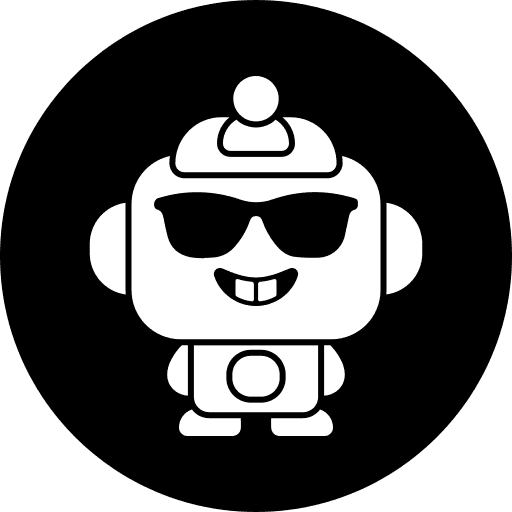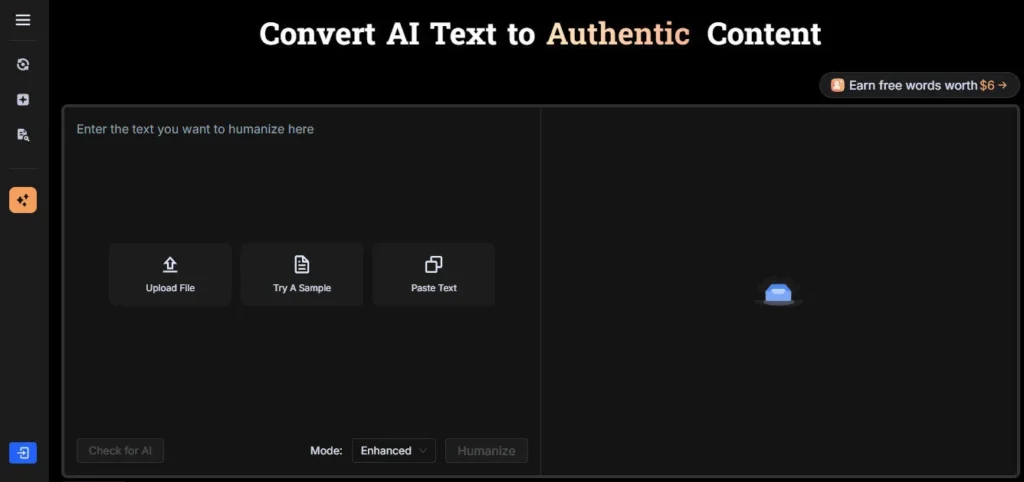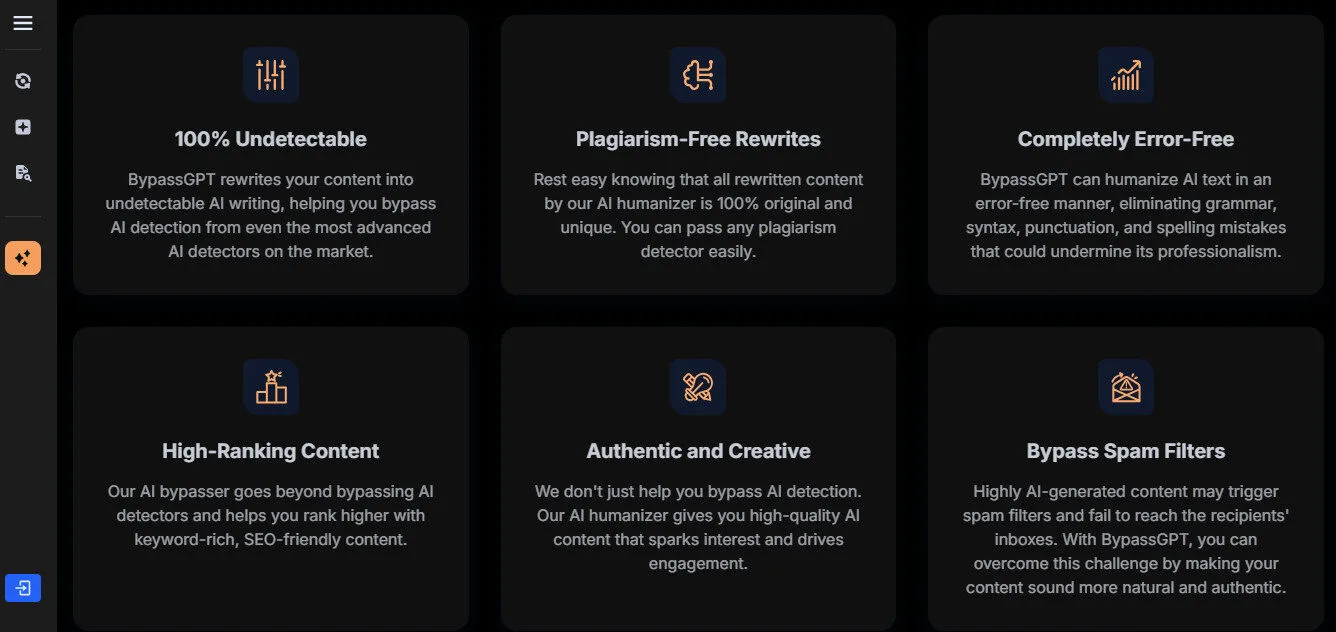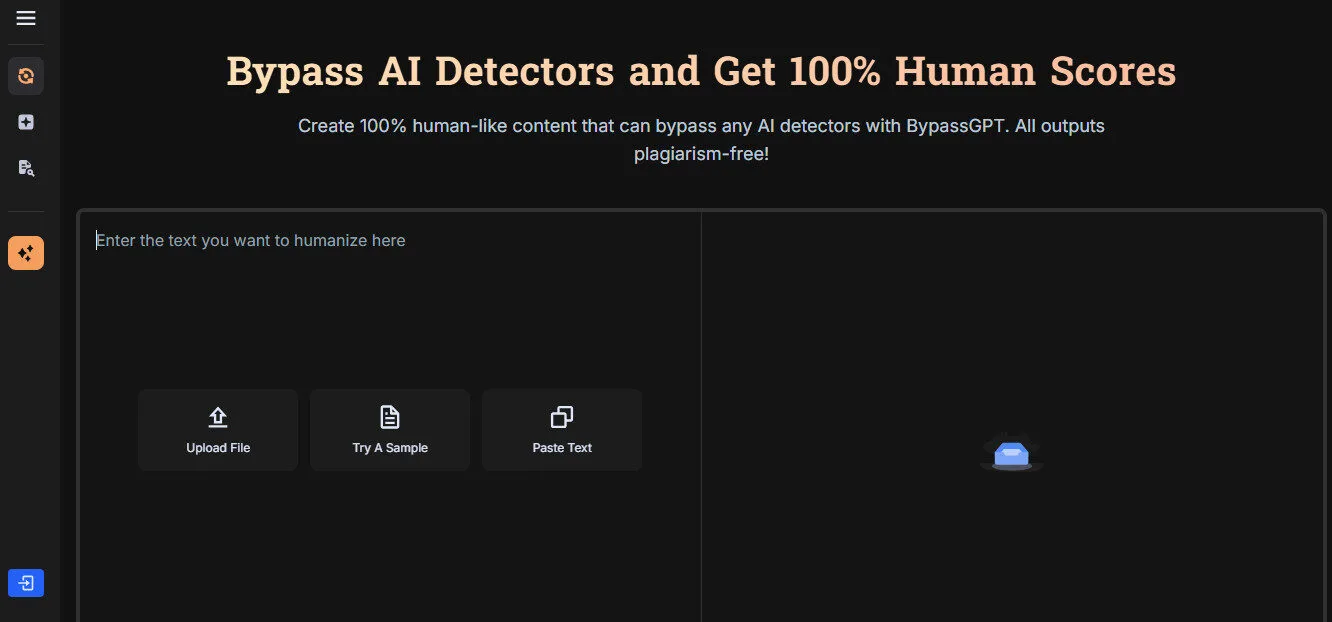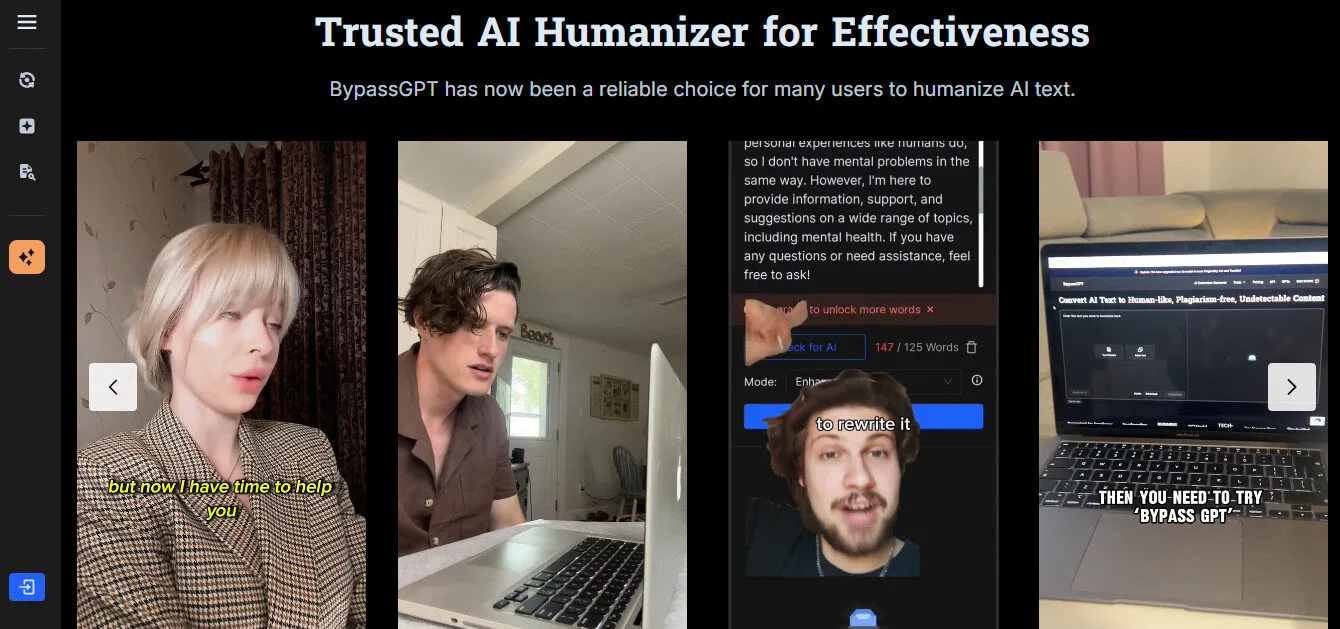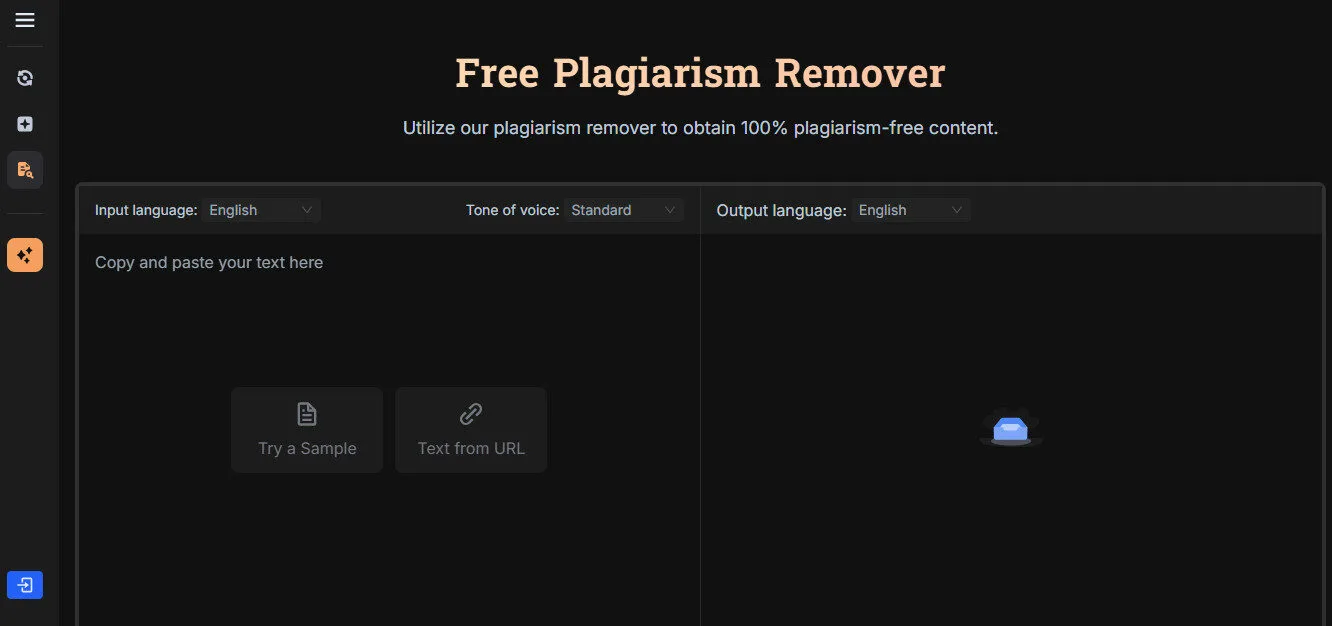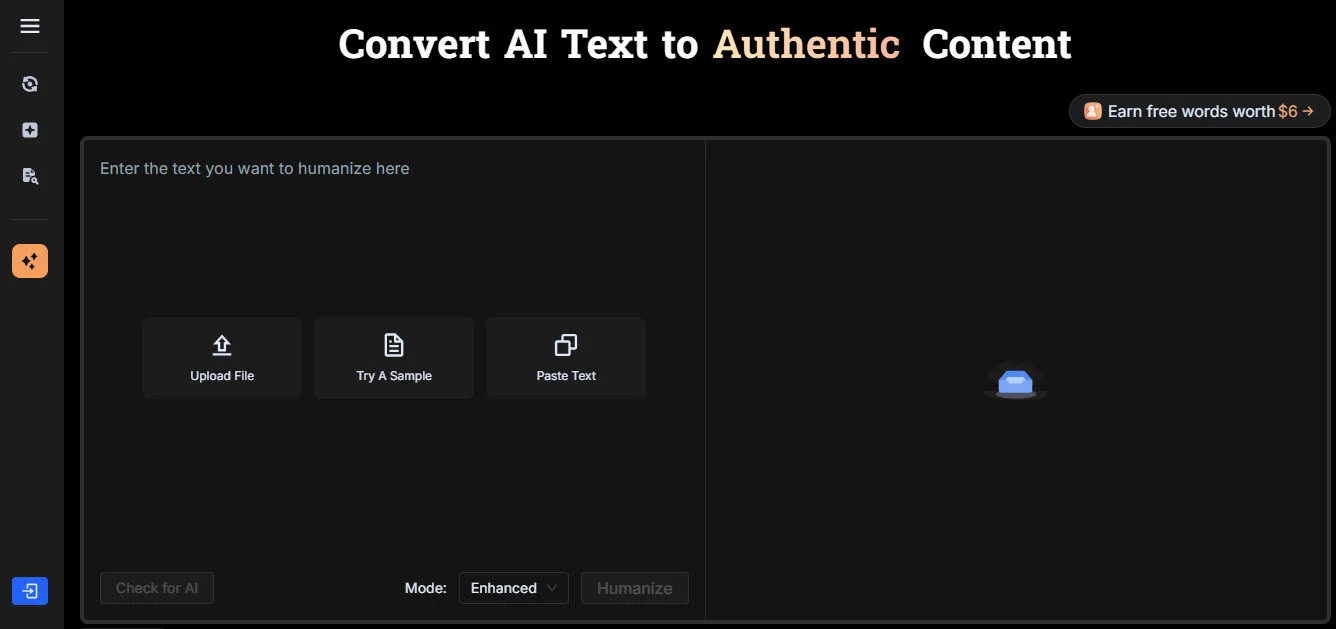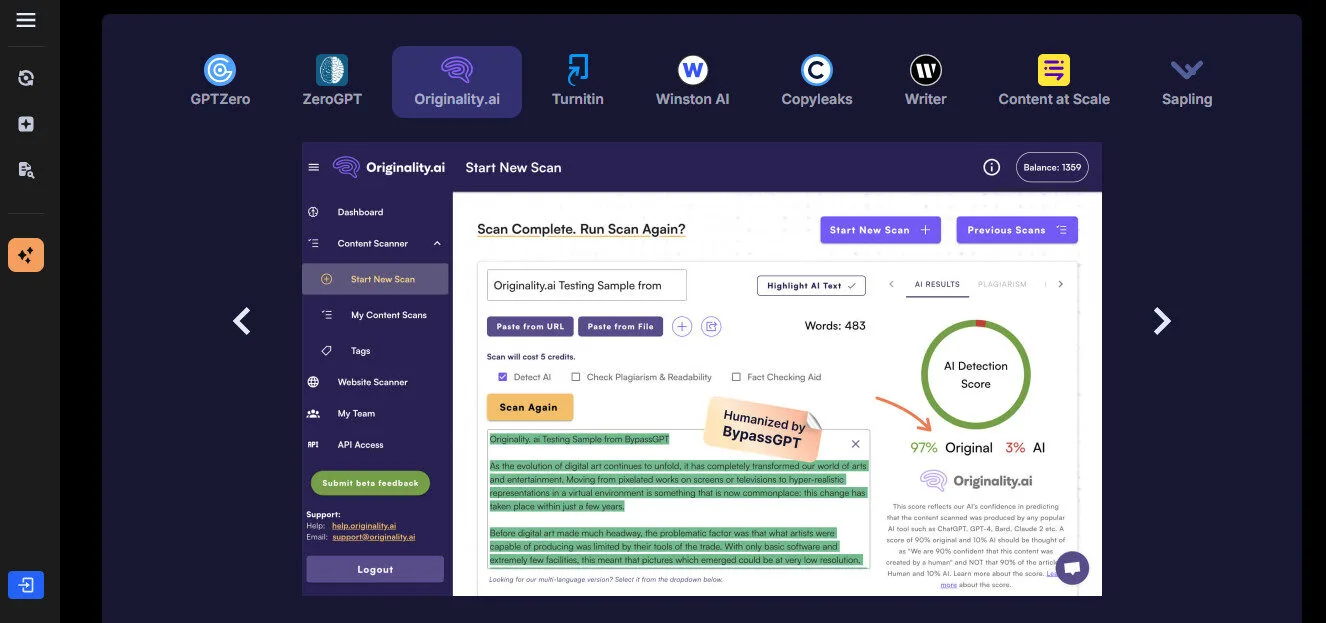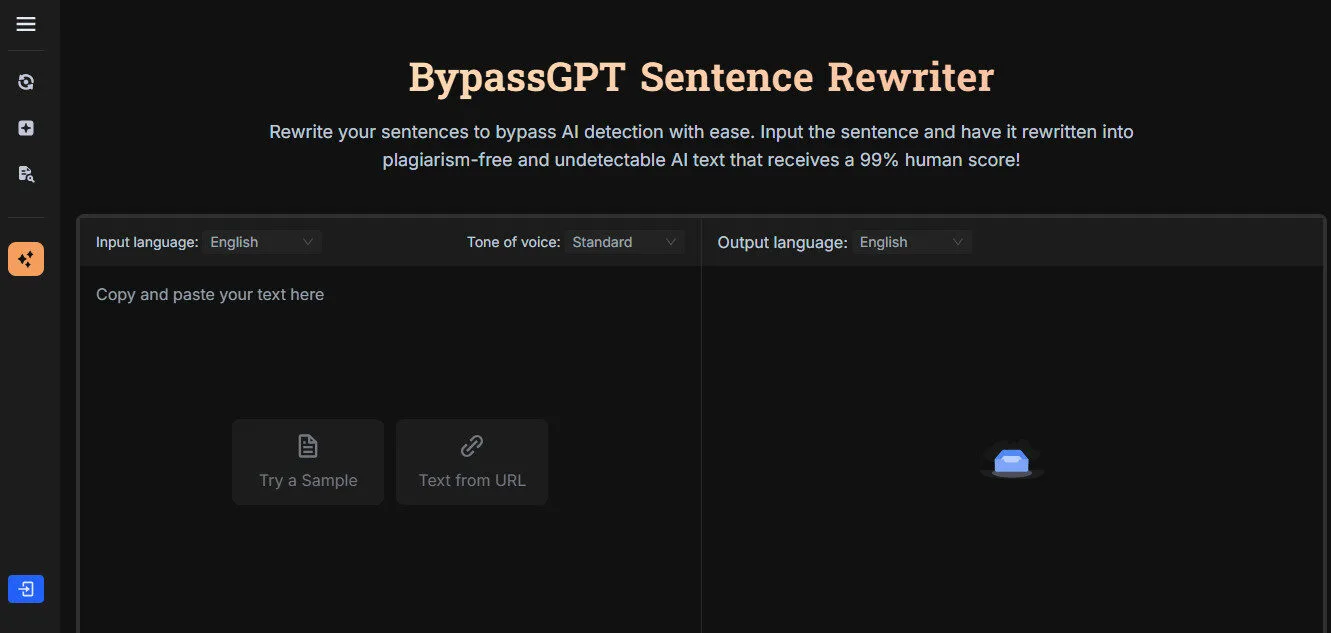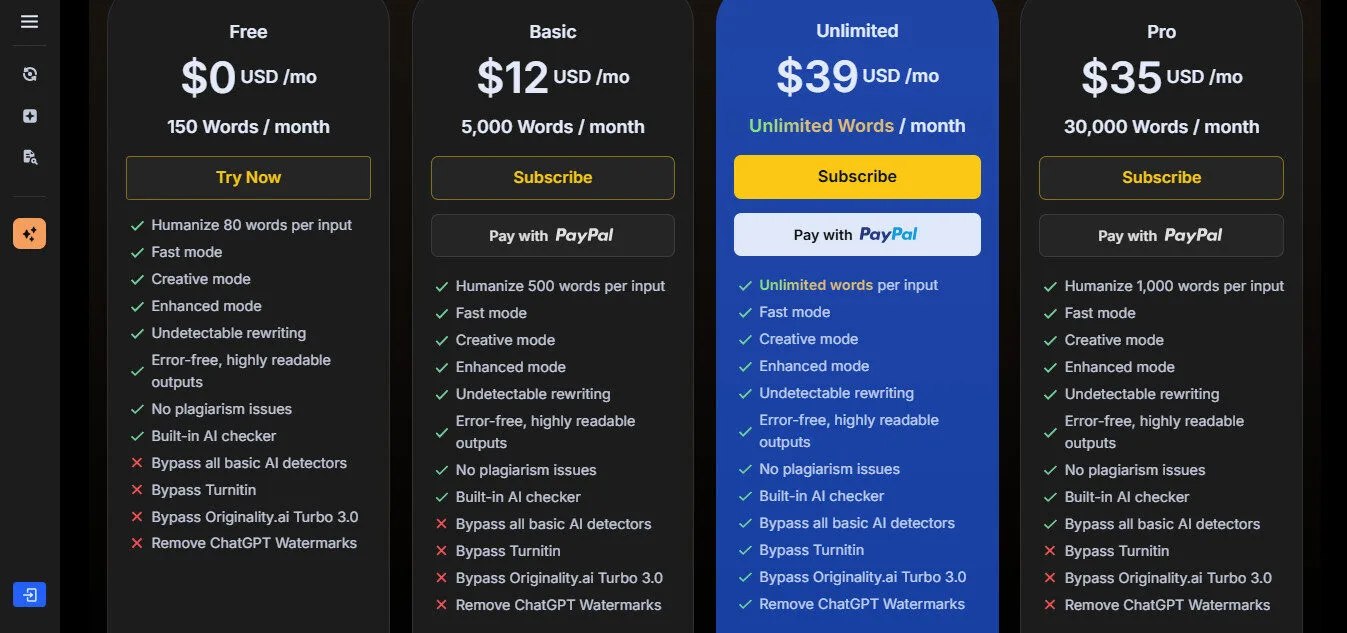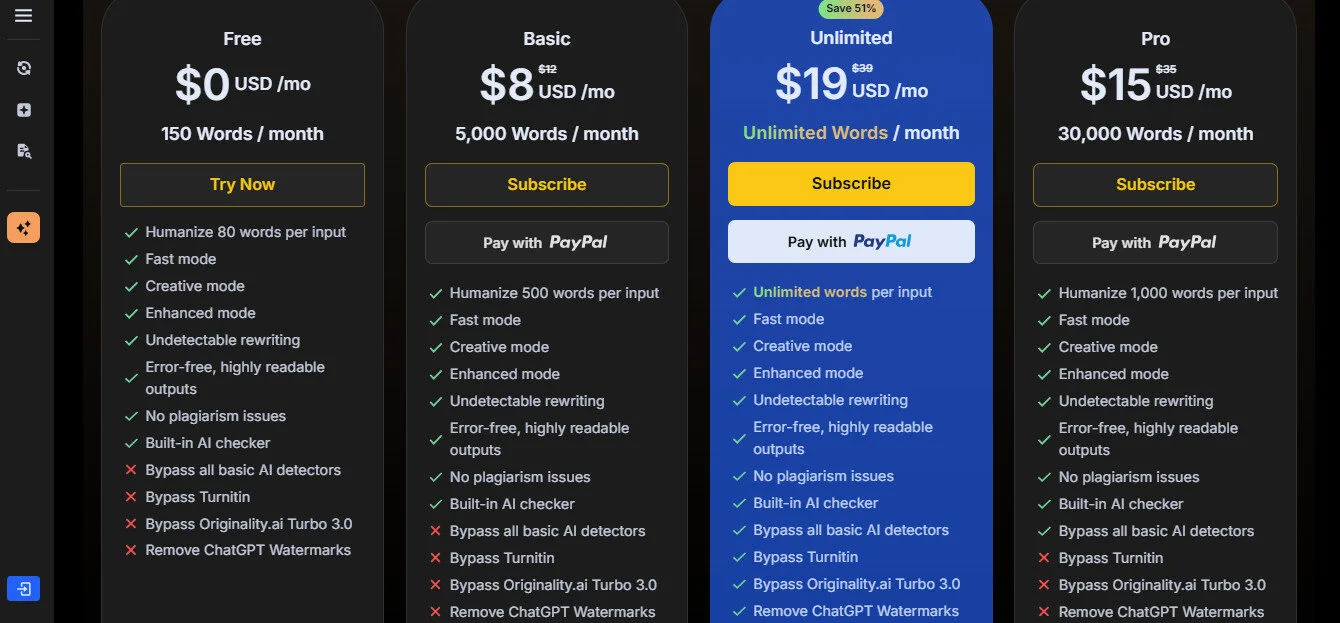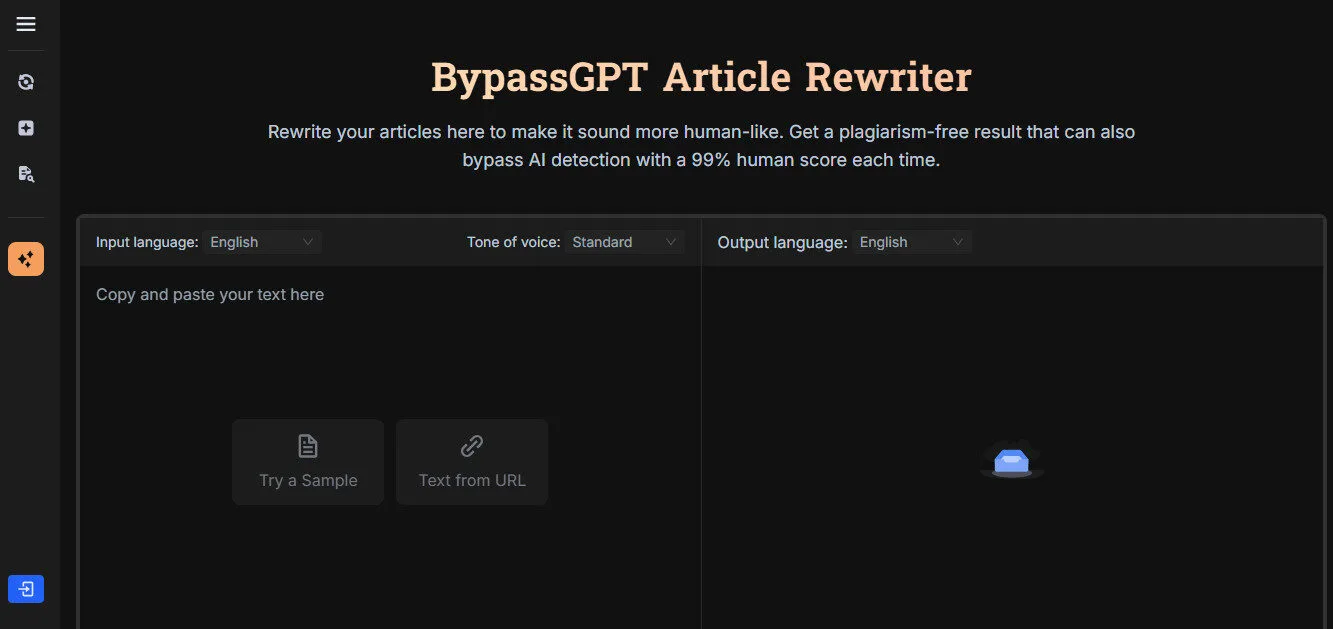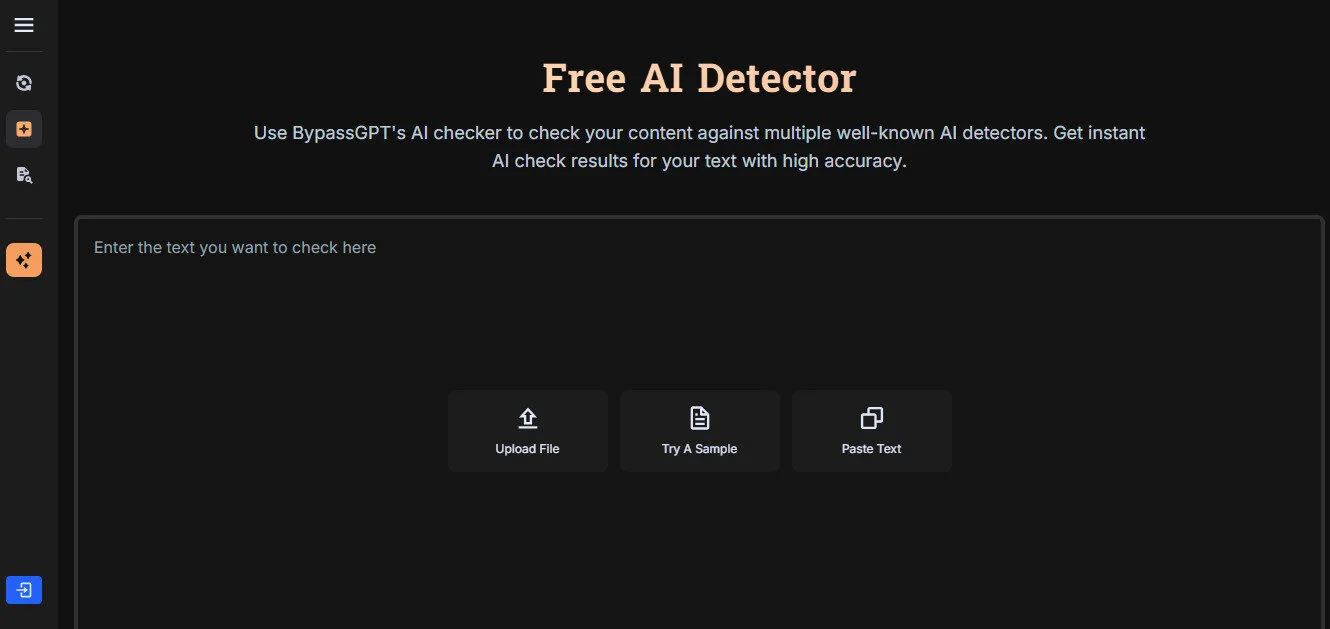Are you a student submitting assignments, a blogger publishing articles, or a marketer crafting copy, constantly battling the rising tide of AI content detection? The convenience of AI-generated text is undeniable, but the fear of being flagged by vigilant AI detectors like Turnitin, Originality AI, or GPTZero looms large.
Table of Contents
ToggleThis isn't just about academic integrity; it's about SEO penalties, spam filters, and the fundamental need for content to sound genuinely human and engaging. You need to leverage AI's speed, but you can't afford the risks associated with detectable, robotic output.
But BypassGPT AI flips that completely.
In this BypassGPT AI Review, we’ll break down how this tool isn’t just another rewriter—it’s a cutting-edge AI detection remover built to transform your AI-generated content into text that convincingly mirrors human writing styles and nuances, ensuring it’s 100% undetectable and plagiarism-free.
We’ll dig into its signature features like its AI Detection Remover, Human-like Rewrites, Plagiarism-Free Outputs, Multilingual Bypass, and SEO-Friendly Content capabilities—then weigh the pros, the cons, and the unexpected use cases you probably haven’t thought of.
You’ll also see how BypassGPT AI stacks up against competitors like GPTinf, Ryne AI, and Undetectable AI.
By the end, you won’t just understand what BypassGPT AI does. You’ll know if it’s the missing link in your content creation and verification workflow.
Let’s dive in.
What is BypassGPT AI?
BypassGPT AI is a leading AI detection remover designed to transform AI-generated text into content that convincingly mirrors human writing styles and nuances.
Its primary function is to help content creators, students, bloggers, and marketers produce text that is 100% undetectable by AI detectors, while also ensuring it is plagiarism-free and error-free.
BypassGPT AI operates as a web-based platform, providing a specialized suite of AI-powered tools focused on content humanization.
It leverages advanced language models trained on extensive human-written datasets to identify AI writing patterns and convert them into natural, authentic-sounding text.
Its main categories of tools include AI detection removal, human-like rewriting, plagiarism prevention, and ensuring SEO-friendly output across multiple languages.
How to Use BypassGPT AI Tutorial
Pros and Cons BypassGPT AI
Top 5 Key Features BypassGPT AI
BypassGPT AI's core strength lies in its specialized features designed to transform AI-generated text into human-like, undetectable, and plagiarism-free content. Here are its top five key features, detailing their functionality, benefits, and practical examples:
I. AI Detection Remover / 100% Undetectable Content: This is the primary function of BypassGPT AI. It employs an advanced AI humanization model, trained on over 200 million texts, to analyze AI-generated content and rewrite it in a way that removes the markers typically identified by AI detectors.
It claims to achieve 100% human scores on various AI detection tools, including Turnitin, Originality.ai, and GPTZero. The process involves sophisticated linguistic analysis and restructuring rather than simple word swaps.
This feature provides critical peace of mind for users who need to submit or publish AI-generated content without fear of detection.
It allows students to adhere to academic integrity policies, bloggers to avoid SEO penalties from search engines, and content creators to confidently use AI for efficiency without compromising authenticity or risking flags from platforms.
Example: A student has drafted an essay using ChatGPT. Before submission, they paste the essay into BypassGPT AI. The tool processes the text, rewriting it to remove AI patterns.
The student then runs the output through an AI detector like Turnitin, and it scores as 100% human, allowing for confident submission.
II. Totally Human-Like Rewrites: BypassGPT AI doesn't just make text undetectable; it actively rephrases and reimagines the content to sound genuinely human.
It's trained to understand context, maintain the original tone, and ensure the integrity of the message while presenting ideas in a fresh, natural way.
This involves altering sentence structures, substituting context-appropriate synonyms, and refining phrasing to mimic human writing styles and nuances.
This ensures that the transformed content is not only undetectable but also highly readable, engaging, and professional.
It helps content resonate more effectively with human readers, improving user experience, driving engagement, and enhancing the overall quality of communication, whether for academic, marketing, or general writing purposes.
Example: A content marketer uses an AI tool to generate a product review. While the initial AI output is informative, it sounds a bit robotic.
They run it through BypassGPT AI, which rewrites sections to include more natural conversational flow, varied sentence structures, and subtle emotional cues, making the review sound genuinely enthusiastic and persuasive to readers.
III. Plagiarism-Free Outputs: Alongside its AI detection removal, BypassGPT AI guarantees that all rewritten content is 100% original and unique. The rewriting process inherently transforms the text sufficiently to avoid triggering plagiarism checkers.
This means users can confidently share or submit their content, knowing it will pass originality scans. This feature is crucial for maintaining academic and professional credibility.
It eliminates concerns about accidental or intentional plagiarism, which can lead to severe consequences. Users can leverage AI for speed without compromising ethical standards or risking penalties from plagiarism detection software.
Example: A freelance writer uses AI to generate content for a client. To ensure the content is unique and doesn't inadvertently contain copied phrases, they run it through BypassGPT AI.
The tool rewrites the text, and a subsequent check with a plagiarism detector confirms 100% originality, giving the writer confidence in their delivery.
IV. Multilingual Bypass: BypassGPT AI extends its humanization capabilities to over 50 languages. It is designed to understand the nuances, idiomatic expressions, and cultural terms of these diverse languages.
This allows users to input AI-generated text in one of the supported languages and receive humanized, undetectable output in the same language.
This broad language support makes BypassGPT AI an invaluable tool for global content creators, international businesses, and multilingual students.
It enables them to produce authentic and undetectable content for diverse audiences worldwide, ensuring that their message is not only understood but also culturally resonant and natural-sounding, regardless of the original AI generation language.
Example: A marketing agency needs to humanize AI-generated ad copy for campaigns targeting both Spanish and German markets.
They input the Spanish AI text into BypassGPT AI, select Spanish, and receive a humanized version. They repeat the process for German, ensuring both localized campaigns have authentic, undetectable copy.
V. SEO-Friendly Content & Spam Filter Bypass: BypassGPT AI's humanization process is designed to go beyond just avoiding AI detection; it also aims to produce content that is SEO-friendly.
This means it can maintain or enhance keyword richness, improve readability, and ensure the content meets quality guidelines for search engines like Google.
Additionally, by making content sound more natural and authentic, it helps ensure that emails and other digital communications avoid triggering spam filters, improving deliverability.
This dual benefit helps users achieve better visibility and engagement for their content. SEO-friendly output can lead to higher search engine rankings and increased organic traffic.
By bypassing spam filters, marketing emails and outreach messages are more likely to reach their intended recipients, improving campaign effectiveness and conversion rates.
Example: A webmaster uses AI to draft new blog posts for their website. They process these drafts through BypassGPT AI, which not only humanizes the text but also ensures that target keywords are naturally integrated and the content structure is optimized for SEO.
This helps the blog posts rank higher on Google and avoids them being flagged as low-quality AI content. Similarly, marketing emails humanized by BypassGPT are less likely to end up in recipients' spam folders.
These five core features collectively position BypassGPT AI as a powerful, specialized, and essential tool for anyone leveraging AI in content creation who needs to ensure authenticity, originality, and broad reach in an increasingly AI-aware digital landscape.
Who Should Use BypassGPT AI?
BypassGPT AI is specifically designed for individuals and organizations who frequently use AI-generated content but need to ensure its authenticity, originality, and human-like quality to avoid detection or penalties.
It caters to a diverse range of users across academic and professional fields.
Ideal Users:
I. Students: Students who use AI tools for drafting essays, assignments, or research papers and need to ensure their submissions are undetectable by academic AI detectors like Turnitin and are plagiarism-free.
Example: A university student drafts a research paper using ChatGPT. Before submitting it, they run the entire text through BypassGPT AI to humanize it, ensuring it passes their university's AI detection software and maintains academic integrity.
II. Bloggers & Webmasters: Individuals who publish AI-written blog posts or web copy and want to avoid SEO penalties from search engines (like Google) that might flag AI content as spam, aiming for higher search engine rankings.
Example: A blogger uses an AI writer to generate several articles to increase their posting rate. They then use BypassGPT AI to humanize these articles, ensuring they are SEO-friendly and less likely to be penalized by Google for being AI-generated, thus protecting their site's ranking.
III. Freelance Writers: Writers who deliver content to clients and need to ensure their work is always undetectable by AI detectors and plagiarism-free, regardless of whether they used AI assistance in the drafting process.
Example: A freelance writer receives a client brief for a series of articles. They use an AI tool for initial content generation to speed up their workflow. Before delivering, they process the content through BypassGPT AI to ensure it's human-like, unique, and passes any AI or plagiarism checks the client might use.
IV. Content Marketing Agencies: Agencies that produce high volumes of AI-generated marketing copy (ads, website content, emails) and need to ensure it converts potential leads, bypasses AI content detectors, and maintains a distinct brand voice.
Example: A content marketing agency generates numerous ad variations using AI for a client campaign. They then run these through BypassGPT AI to humanize them, ensuring the ads are engaging, avoid spam filters, and are not flagged as AI-generated by ad platforms, maximizing campaign effectiveness.
V. Researchers: Professionals who use AI tools to assist with literature reviews or drafting sections of research papers and need to ensure the final output is original, well-structured, and free from AI markers.
Example: A researcher uses an AI tool to summarize several academic papers. To integrate these summaries into their own research document without appearing AI-generated, they process the summaries through BypassGPT AI for humanization and originality.
Uncommon Use Cases:
I. Legal Document Refinement: Legal professionals can use BypassGPT AI to refine AI-generated drafts of contracts, briefs, or summaries, ensuring the language sounds natural and precise while adhering to legal standards, especially if using AI for initial drafting.
Example: A legal firm uses AI to draft preliminary legal briefs. They then use BypassGPT AI to humanize the language, ensuring it reads as if written by a human legal expert, maintaining professionalism and clarity for court submissions.
II. Medical Writing & Patient Education: Medical writers or healthcare providers using AI to draft medical reports, research papers, or patient education materials can use BypassGPT AI to ensure complex medical details are presented in a clear, consistent, and human-readable way.
Example: A medical writer uses AI to generate a patient education leaflet on a new treatment. They then use BypassGPT AI to simplify the technical jargon and make the language more empathetic and accessible for a general audience, ensuring better patient understanding.
III. E-commerce Product Description Optimization: Online retailers can use BypassGPT AI to transform AI-generated product descriptions into unique, engaging, and SEO-friendly content that drives conversions and organic traffic without appearing robotic.
Example: An e-commerce manager generates hundreds of product descriptions using an AI tool. They then process these through BypassGPT AI to ensure each description is unique, sounds natural, and is optimized to rank higher on search engines, enhancing their online store's appeal.
IV. Language Translation & Localization Enhancement: For businesses expanding globally, BypassGPT AI can refine AI-translated content to ensure it sounds culturally appropriate and natural in the target language, going beyond literal translation.
Example: A company uses AI for initial website translation into multiple languages. They then use BypassGPT AI to “humanize” these translations, ensuring idioms and cultural nuances are correctly adapted, making the content resonate more deeply with international audiences.
V. Internal Communications & HR Document Humanization: Companies using AI to draft internal memos, HR policies, or training materials can use BypassGPT AI to ensure these documents sound empathetic, clear, and genuinely human, fostering better employee engagement.
Example: An HR department uses AI to draft a new company policy document. They then run it through BypassGPT AI to ensure the tone is supportive and clear, avoiding any robotic or overly formal language that might alienate employees.
In essence, if your workflow involves AI-generated text and you need to ensure its authenticity, originality, and human-like quality across various applications, BypassGPT AI provides the specialized tools to transform your content and navigate the complexities of AI detection with confidence.
BypassGPT AI Pricing
BypassGPT AI offers Monthly and Yearly Plans as Free, Basic, Unlimited, and Pro monthly plans, designed for various levels of AI humanization needs.
BypassGPT AI Monthly Pricing Plan
Free Plan ($0/month) : It includes 150 Words per month, 80 words per input, Fast mode, Creative mode, Enhanced mode, Undetectable rewriting, Error-free, highly readable outputs, No plagiarism issues, and a Built-in AI checker.
It does not include Bypass Turnitin or Remove ChatGPT Watermarks. If you're looking to try AI humanization with basic features and a limited word count, this free plan is suitable for you.
Basic Plan ($12/month) : It includes 5,000 words per month, 500 words per input, Fast mode, Creative mode, Enhanced mode, Undetectable rewriting, Error-free, highly readable outputs, No plagiarism issues, and a Built-in AI checker.
It also includes Bypass all basic AI detectors and Bypass Turnitin, but does not include Remove ChatGPT Watermarks. If you're a regular user needing more humanization capacity and the ability to bypass advanced detectors, this basic plan is for you.
Unlimited Plan ($39/month) : It offers Unlimited Words per month and unlimited words per input. It includes Fast mode, Creative mode, Enhanced mode, Undetectable rewriting, Error-free, highly readable outputs, No plagiarism issues, a Built-in AI checker, Bypass all basic AI detectors, and Bypass Turnitin.
It also removes ChatGPT Watermarks. If you're a power user who requires unlimited words for humanization and a full suite of features to bypass various AI detectors, this plan is for you.
Pro Plan ($35/month) : It includes 30,000 Words per month, 1,000 words per input, Fast mode, Creative mode, Enhanced mode, Undetectable rewriting, Error-free, highly readable outputs, No plagiarism issues, and a Built-in AI checker.
It also includes Bypass all basic AI detectors and Bypass Turnitin, but does not include Remove ChatGPT Watermarks. If you have a specific need for a high volume of words per month but don't need unlimited access, this pro plan is for you.
BypassGPT AI Pricing Plan (Yearly)
Basic Plan ($8/month) : It includes 5,000 Words per month, Humanize 500 words per input, Fast mode, Creative mode, Enhanced mode, Undetectable rewriting, Error-free, highly readable outputs, No plagiarism issues, and a Built-in AI checker.
It also includes Bypass all basic AI detectors and Bypass Turnitin, but does not include Remove ChatGPT Watermarks. If you're a regular user needing more humanization capacity and the ability to bypass advanced detectors with significant annual savings, this plan is for you.
Unlimited Plan ($19/month) : It offers Unlimited Words per month, Unlimited words per input, Fast mode, Creative mode, Enhanced mode, Undetectable rewriting, Error-free, highly readable outputs, No plagiarism issues, a Built-in AI checker, Bypass all basic AI detectors, and Bypass Turnitin.
It also removes ChatGPT Watermarks. If you're a power user who requires unlimited words for humanization and a full suite of features to bypass various AI detectors with significant annual savings, this unlimited plan is for you.
Pro Plan ($15/month) : It includes 30,000 Words per month, Humanize 1,000 words per input, Fast mode, Creative mode, Enhanced mode, Undetectable rewriting, Error-free, highly readable outputs, No plagiarism issues, and a Built-in AI checker.
It also includes Bypass all basic AI detectors and Bypass Turnitin, but does not include Remove ChatGPT Watermarks. If you have a specific need for a high volume of words per month but don't need unlimited access, this plan is for you.
Disclaimer: Pricing details may change. Visit the official BypassGPT AI website for the latest information.
Top 3 BypassGPT AI Alternatives?
Looking for BypassGPT alternatives? Please Check out below Top 3 BypassGPT AI alternatives options to consider:
GPTinf Best for AI Detection Bypass
Ryne AI Best for Humanizing AI Text
Undetectable AI Best for AI Content Humanization
Each BypassGPT AI alternative offers unique features that might better suit your specific needs. Consider your primary use case, budget, and required features when choosing between these options.
What Makes BypassGPT AI Unique?
BypassGPT AI distinguishes itself in the AI content humanization market through its singular focus on achieving 100% human scores on AI detectors, its advanced human-like rewriting technology, and its comprehensive multilingual support.
It is specifically engineered to bypass a wide range of popular AI detectors, including Turnitin, Originality.ai, and GPTZero, by reimagining content rather than just swapping words.
The tool is trained on over 200 million data points to understand context and maintain original tone, ensuring unique and safe rewrites.
Furthermore, its ability to bypass AI detection in over 50 languages, understanding their nuances and idiomatic terms, sets it apart for global users.
BypassGPT AI Compatibilities & Integrations
BypassGPT AI is designed to integrate smoothly into existing content creation and publishing workflows, primarily through its web-based platform and API capabilities. Its focus is on providing a seamless experience for transforming AI-generated text.
I. Platform & Accessibility:
Web-Based Application: The core of BypassGPT AI is its cloud-based web application. This ensures universal accessibility from any modern web browser on any operating system (Windows, macOS, Linux, Chrome OS) and device (desktop, laptop, tablet, smartphone).
This universal accessibility means users can manage their content humanization tasks from virtually anywhere with an internet connection, eliminating the need for software installations. It provides flexibility for individuals and teams to work remotely and collaboratively.
II. Content Input & Output Compatibility:
Copy & Paste: Users primarily interact with BypassGPT AI by copying their original AI-generated content into the platform's input portal and then pasting the humanized output wherever needed.
File Uploads: While not explicitly detailed for all features on the main page, the platform supports file uploads (e.g., DOCX, DOC, PDF) for processing, particularly for features like plagiarism removal or general humanization.
This straightforward input/output method ensures broad compatibility with virtually any text-based content source or destination, making it easy for users to integrate BypassGPT AI into their existing writing and publishing workflows without complex setup.
III. AI Model Compatibility (Input Source):
Works with Any LLM: BypassGPT AI is designed to humanize text generated by any large language model (LLM), including popular ones like ChatGPT, GPT-4, Gemini, and Claude.
This broad compatibility ensures that users are not locked into a specific AI content generator. They can use their preferred AI writing tool and then rely on BypassGPT AI for the crucial humanization and undetectability step, providing maximum flexibility in their AI content pipeline.
IV. API (Application Programming Interface): BypassGPT AI offers API solutions for businesses. This allows for seamless integration of its AI humanization capabilities into custom applications, business solutions, or automated workflows.
The API provides significant value for larger organizations or agencies that need to process vast volumes of content programmatically or integrate humanization directly into their proprietary content management systems.
It saves time, money, and effort in product development by leveraging BypassGPT's core technology. A large content marketing agency could integrate BypassGPT AI's API into their internal content production system.
As soon as an AI-generated article draft is created, it could automatically be sent to BypassGPT via the API for humanization before being passed to a human editor for final review.
V. White-Label Solutions: BypassGPT AI offers white-label AI bypass solutions for businesses. This allows companies to integrate BypassGPT's AI bypasser tool as part of their own branded business offerings.
This is particularly beneficial for SaaS companies or agencies that want to offer AI humanization services under their own brand without developing the underlying technology themselves. It enables them to expand their service offerings and strengthen their core business operations.
In summary, BypassGPT AI's compatibility and integration ecosystem is highly focused on its core function of AI humanization.
Its web-based accessibility, broad input compatibility, and powerful API make it a flexible and scalable solution for integrating undetectable AI content into various academic, professional, and business workflows.
How We Rated It BypassGPT
Summary BypassGPT AI Review
You're using AI for content creation, but the constant anxiety of AI detection, plagiarism flags, and robotic-sounding text is holding you back. You need to leverage AI's efficiency, but you can't afford the risks associated with detectable, unoriginal, or inauthentic content.
BypassGPT AI changes that. It’s not just another rewriter. It’s your cutting-edge AI detection remover, built to transform your AI-generated content into text that convincingly mirrors human writing styles and nuances, ensuring it’s 100% undetectable and plagiarism-free.
Designed for students, bloggers, freelance writers, webmasters, and content marketing agencies, BypassGPT AI is the specialized tool that brings confidence and authenticity to your AI-assisted content.
100% Undetectable Content: Transform AI text to bypass even the most advanced AI detectors with high success.
Totally Human-Like Rewrites: Reimagines content to sound genuinely natural, maintaining original tone and context.
Plagiarism-Free Outputs: Guarantees unique content, ensuring you pass any plagiarism checker.
Multilingual Bypass: Humanize AI text in over 50 languages, understanding their unique nuances.
SEO-Friendly Content & Spam Filter Bypass: Create content that ranks higher and ensures emails reach their inbox.
It’s specialized. Authentic. And ridiculously effective.
But here’s the kicker: BypassGPT AI doesn’t just “rewrite”—it intelligently re-engineers AI content to mimic human subtlety, ensuring your message is delivered without compromise. That’s its true superpower. No more detection worries. Just confident, human-like AI content.
Now, it’s not flawless. Some user reviews cite inconsistent effectiveness and the need for manual review. But for most users, it’s a crucial tool for navigating the complexities of AI content in today's digital landscape.
We’re talking about a serious risk-mitigator here—not a novelty.
If you’re constantly battling the challenges of AI detection and content authenticity, BypassGPT AI becomes your essential partner—without breaking your flow.
We’ll size it up against options like:
GPTinf – Best for AI Detection Bypass Rewrites text to make AI-generated content undetectable while maintaining meaning and flow.
Ryne AI – Best for Humanizing AI Text Transforms robotic AI outputs into natural, fluent writing that passes AI detectors.
Undetectable AI – Best for AI Content Humanization Converts machine-like text into authentic, human-sounding content across formats.
But BypassGPT AI isn’t chasing every use case. It’s laser-focused on ensuring your AI-generated content is undetectable and genuinely human—right where you need it.
That’s the edge.
BypassGPT AI FAQs:
What is BypassGPT AI's primary function?
BypassGPT AI's primary function is to transform AI-generated text into human-like, undetectable, and plagiarism-free content.
What are the top 5 key features of BypassGPT AI?
Its top 5 features are AI Detection Remover / 100% Undetectable Content, Totally Human-Like Rewrites, Plagiarism-Free Outputs, Multilingual Bypass, and SEO-Friendly Content & Spam Filter Bypass.
How does BypassGPT AI make content undetectable?
It uses an advanced AI humanization model trained on extensive human-written data to rewrite AI patterns into natural, human-like text.
Does BypassGPT AI guarantee plagiarism-free content?
Yes, it guarantees that all rewritten content is 100% original and unique, designed to pass any plagiarism detector.
How many languages does BypassGPT AI support for humanization?
BypassGPT AI supports humanizing AI text in over 50 different languages.
Can BypassGPT AI help with SEO?
Yes, it aims to produce SEO-friendly content by maintaining keywords and improving readability, helping content rank higher and avoid Google penalties.
Does BypassGPT AI work with content from any AI generator?
Yes, it is designed to humanize text generated by any large language model, including ChatGPT, GPT-5, Gemini, and Claude.
What is the main benefit of using BypassGPT AI for content marketers?
It helps content marketers produce engaging, authentic copy that bypasses AI content detectors, avoids spam filters, and maintains brand voice, leading to better conversions.
Is there an API available for BypassGPT AI?
Yes, BypassGPT AI offers API solutions for businesses to integrate its humanization capabilities into custom applications and workflows.
Who is the target audience for BypassGPT AI?
The target audience includes students, bloggers, freelance writers, webmasters, and content marketing agencies who use AI-generated content.
Did you find this content helpful?

